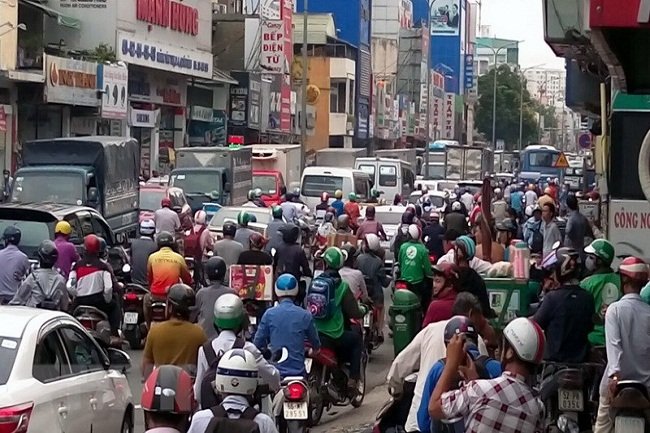[ad_1]
The HCMC government is expected to convene a meeting next week to discuss a plan on banning motorcycles in the downtown area, after a study to this effect has been completed and handed over to the city by the Transport Development and Strategy Institute under the Ministry of Transport.

The plan, with an aim to ease traffic congestion and fight air pollution in the downtown area, sets out a phase-out strategy between now and 2030, targeting to have no motorcycles in central business districts alongside the development of transit systems.
For the immediate future from now to 2020, motorcycles should be restricted during rush hours on high-traffic routes including Truong Son in Tan Binh District and Nguyen Thi Minh Khai in District 1, while two other streets of Pasteur and Nam Ky Khoi Nghia will be closed to motorcycles in the daytime, from 7 a.m. to 7 p.m. Between 2021 and 2025, more stringent motorcycle restrictions will apply across District 1 before a complete ban applies in 2030. The ban will also apply in other areas in districts 3, 5 and 10.
This déjà-vu approach – whereby State agencies tend to grab the longer end of the stick – to issue bans whenever a solution is needed to a sticky situation has in many instances failed to address the core of the problem. In this case, the Transport Development and Strategy Institute also opts for the easier job of banning motorcycles while skipping other peculiar features of the city, and shunning the main causal reason behind traffic congestion.
No matter how transit systems are developed, the demand for motorcycle rides remains huge. In the city, there are narrow alleys kilometers long where residents have no choice but to resort to bikes, because even minibuses cannot move in. In the city, there are many jobs assumed by residents that require motorcycles, such as deliverymen. In the city, it is the increasing number of private cars, rather than bikes, that threaten the traffic flow in the coming years.
But the root cause of traffic congestion in HCMC lies elsewhere. In central business districts, numerous high-rise buildings have been springing up lately, exerting increasing pressure on the obsolete infrastructure. There have been schemes to ease the population density in inner-city areas, including the relocation of major public or commercial services facilities like universities or hospitals or shopping malls to outlying districts, but the current development contradicts such schemes.
Of course, the trend for a modern mega-city like HCMC must be to develop transit systems like metro, monorail and bus lines, and to gradually restrict private cars and motorcycles. But such a transformation should take another approach: instead of an outright ban, policymakers should resort to measures to discourage those transport means. Higher costs of riding private vehicles will do the job better, since only those with the earnest demand to ride their own bikes or cars will still need them.
SGT
[ad_2]
Source link
